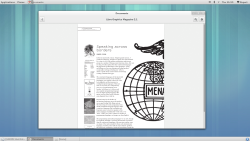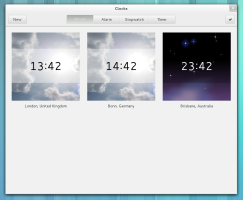GNOME 3.8 brings polish and new Classic Mode

![]() The new Classic Mode is implemented with GNOME Shell extensions
The new Classic Mode is implemented with GNOME Shell extensions
With GNOME 3.8, the developers of the GNOME Project have released the latest version of their open source desktop environment for Linux and Unix systems. The release brings a number of major new features, such as the new Clocks application, enhanced search functionality, new privacy settings and a number of design changes throughout the desktop environment. The redesign of the Activities and Applications interface is supposed to make finding the right application easier and the Settings application has gained four new configuration panels.
GNOME's file manager, its web browser and the Contacts and Documents applications have also seen some work. GNOME 3.8, the first major version of the desktop since GNOME 3.6 was released in September 2012, also drops the Fallback Mode for systems without hardware accelerated graphics and introduces a new Classic Mode instead; where hardware accelerated graphics are not available, GNOME now uses llvmpipe.
The new Clocks core application allows users to set up clocks to track the time in different timezones and presents them in a visually pleasing way that shows at a glance if it is night or day in that particular region. Users can also set a number of alarms that will alert them with an audible signal and a notification and they can also use stop watch and timer functions. The new privacy settings allow users to hide their name from the upper menu bar, to disable the collection of usage and history data desktop-wide and to delete items in the trash and temporary files. This allows them to control how much data GNOME collects on them and displays on screen. Other panels in the Settings application let users customise which applications can use GNOME's notification system and which provide data to the desktop-wide search bar in the Activities screen.
GNOME 3.8 brings polish to a number of different parts of the desktop. The Activities screen now shows the user's most frequently used applications and allows them to group applications into folders through a drag-and-drop interface that will be familiar to those who use Android or iOS devices. Bigger icons and previews and more generous spacing make both the Activities and Applications screens seem less cluttered. Aside from offering results for applications themselves, the search bar at the top of the Activities view now shows results from within applications as well as contacts, files and documents. Improved animation rendering makes transitions and other animations such as window resizing a smoother experience. In a concession to users who had missed the feature in the last release, GNOME's file manager Nautilus has regained the ability to show multiple levels of directories in a tree view.
The web browser in GNOME 3.8, now simply named "Web", has also been redesigned and uses the multi-process WebKit2 API layer under the hood; this, according to its developers, will improve performance and stability. With WebKit2, plugins run in their own processes which means a crash will not impact the browser itself. The isolation of process also helps security, something that Google's Chrome browser and Firefox have demonstrated in the past. The developers have also been able to use the new architecture to get Adobe's Flash plugin working out of the box again; Flash was broken in the browser since it migrated to GTK+ 3.

![]() Like many parts of the desktop, the message popup has gained a more polished look
Like many parts of the desktop, the message popup has gained a more polished look
GNOME's Fallback Mode has been replaced with a new Classic Mode which is, like its predecessor, available from the desktop's login screen. Classic Mode presents users with a desktop environment that is more akin to GNOME 2. It uses GNOME Shell and implements this interface look by using a number of extensions from the GNOME Extensions web site. Like GNOME 3's standard interface, it uses hardware accelerated graphics, or, if those are not available on the system, the llvmpipe technology, to render its graphics with the CPU.
A detailed explanation of all the new features in GNOME 3.8 is available from the release notes and its source code is available from the GNOME Project Git servers. The developers recommend users to install official packages from their distribution's repositories when they become available.
(fab)




![Kernel Log: Coming in 3.10 (Part 3) [--] Infrastructure](/imgs/43/1/0/4/2/6/7/2/comingin310_4_kicker-4977194bfb0de0d7.png)

![Kernel Log: Coming in 3.10 (Part 3) [--] Infrastructure](/imgs/43/1/0/4/2/3/2/3/comingin310_3_kicker-151cd7b9e9660f05.png)
















